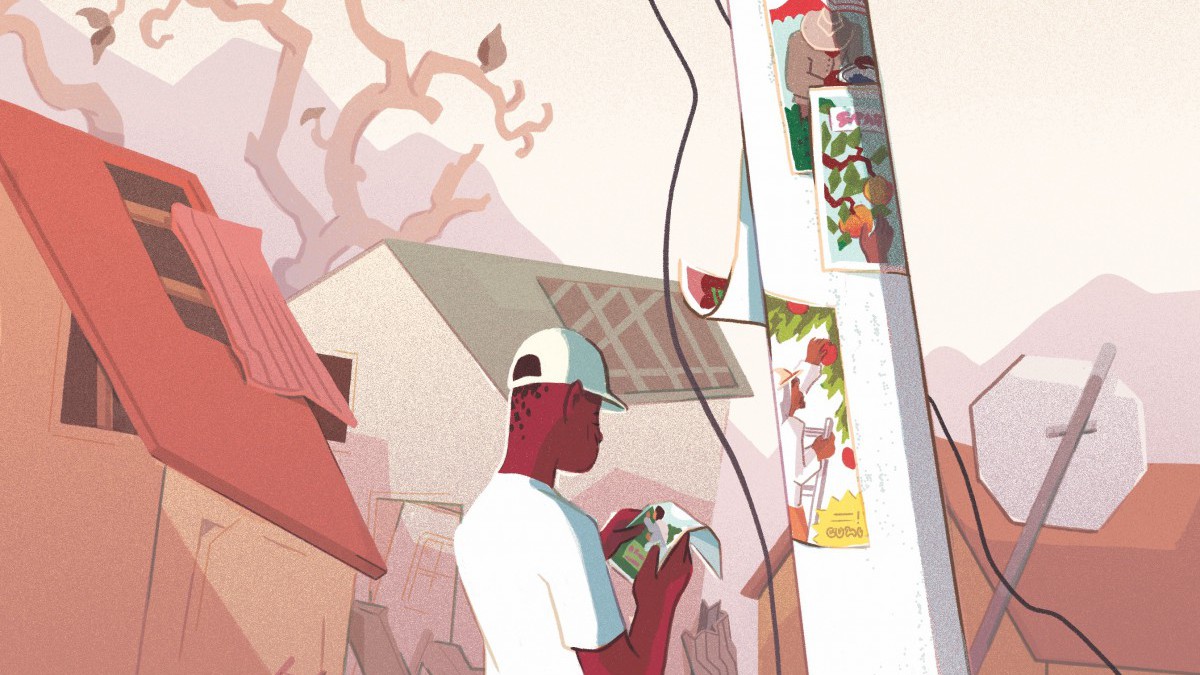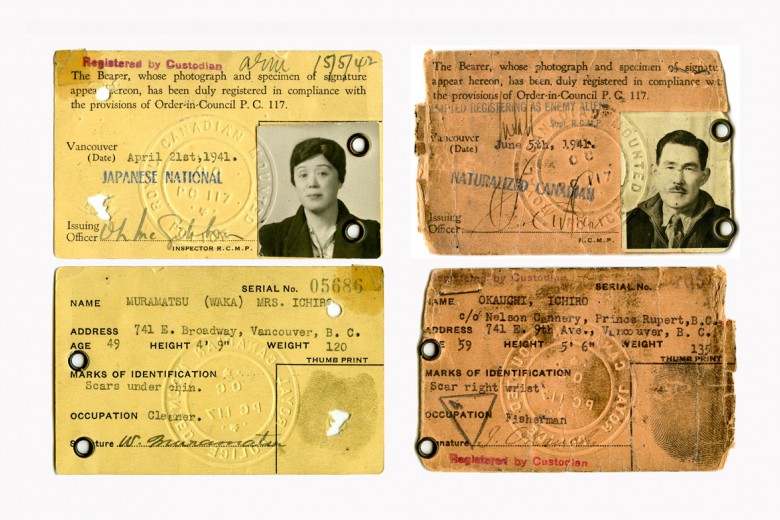In 2017, wildfires in B.C. captured headlines around the world. Canadians from coast to coast donated generously to those whose homes and businesses were impacted. But there were some agricultural workers whose precarity rendered them nearly invisible, even as they continued to labour in the heat and the smoke. Andrea,* a former blueberry worker who was employed under the Seasonal Agricultural Worker Program during the disaster, vividly remembers what it was like to work during the fires.
“There was a mix of colours, red, grey, brown. It was covering the sky. You couldn’t see the sky and it was hard to breathe. And the smoke looked like clouds coming down on the ground. I actually fainted. I was outside and I have never felt the heat like that before. I could see the heatwave – that’s how bad it was. I tried to get some water, ice water, and I just drank it down. By the time I was finished I guess my body went into a shock because I was so hot,” Andrea recalls. “I passed out every day. You see little patches in the grass where fire had started burning and they had put it out. A lot of other workers fainted as well. It was really bad.”
The occupational health and safety impacts of the heat and the fires stretched far beyond the blueberry fields where Andrea worked, impacting workers in essentially every sector of the agricultural industry. Many of the impacted workers are, like Andrea, migrants who are brought in on temporary work visas to fill labour shortages. They often come attempting to escape the climate crisis in their countries of origin, only to arrive in Canada and face extreme climate impacts here. But climate change is inescapable, and when workers arrive, they find themselves again on the front lines of climate catastrophe with little to no support.
Temporary work in the climate crisis
When B.C. flooded in November 2021, Justice for Migrant Workers (J4MW), an all-volunteer grassroots activist group based in Ontario, wrote an urgent appeal to the federal government, pointing out that the increasing volume and intensity of climate-related disasters has created significant challenges for the agricultural industry, and by extension, agricultural workers. While both provincial and federal governments have developed support mechanisms to assist the industry, to date, no steps have been taken to support the industry’s migrant workers.
The climate impacts of the past few years have only been compounded by the ongoing COVID-19 pandemic, which tore through the agricultural sector, killing, disabling, and economically devastating migrant workers. At the start of the pandemic, J4MW requested immediate and urgent action to extend employment insurance benefits to migrant workers who were stranded, both in Canada and in their home countries. Unemployed and unable to access their country’s own social safety net, restrictive work permits denied migrants access to benefits despite the strong labour attachment that this community has to the agricultural industry.
Like other migrant front-line workers, agricultural workers on temporary visas face extreme precarity. Their rights and their residency are tied to their employment, so when environmental and public health crises like the B.C. wildfires and COVID-19 pandemic arise, they have little freedom to refuse unsafe working conditions. Their choices are to work in whatever conditions they are subjected to or risk deportation back to a country experiencing even greater impacts from the climate crisis and imperialism. “Canada [was] built on migrants’ backs, like we are still doing today,” Andrea says. “[Migrant workers] are being exploited, but because there is not enough where we come from, we still keep trying and fighting for better.”
Instead of providing people fleeing climate disaster with refuge, the Global North is increasing the securitization of its borders and expanding migrant worker schemes.
As the impacts of climate change worsen and the number of climate refugees multiplies across the globe, Canada is increasing the number of temporary foreign workers to address labour shortages. In 2021, Canada employed approximately 61,000 temporary foreign workers in the agriculture sector, an increase of 6,000 people from the previous year. The federal government permits employers in seven sectors with “demonstrated labour shortages,” including agriculture, to employ up to 30 per cent of its workforce through the Temporary Foreign Worker Program (TFWP) in the low-wage category for up to two years.
Other countries responsible for the climate crisis are following in Canada’s footsteps. In New Zealand and Australia, industry groups claim guest worker schemes help the countries ensure climate resiliency. Over the last decade, policy think tanks in Australia have looked at the potential opportunities that climate change opens up for industry. Proponents of the Pacific Australia Labour Mobility program, a new migration scheme that combines the existing Seasonal Worker Program and Pacific Labour Scheme into one managed migration project, brings up to 35,000 Pacific Islanders to work in Australia’s agricultural industry. Recently it was announced that a new pathway to permanent residency scheme will be available for up to 3,000 participants.
Scholar Carmen G. Gonzalez argues that managed migration schemes obscure the respective roles of climate change and extractive industries like agriculture in displacing people, particularly people in the Global South. Instead of providing people fleeing climate disaster with refuge, the Global North is increasing the securitization of its borders and expanding migrant worker schemes.
Countries in the Global North expand migrant worker programs claiming they’ll fill labour shortages, while promoting economic development and climate resilience in the Global South. This framing, Gonzalez says, portrays migrants as “entrepreneurs engaged in self-help who enhance the resilience of their communities by taking jobs abroad and sending home remittances,” instead of people displaced by climate change who have few options but to accept precarious, low-wage work abroad.
Occupational health and safety in a world on fire
Thousands of kilometres east of the B.C. blueberry farm where Andrea worked, migrant farm workers employed in southwestern Ontario’s multibillion-dollar greenhouse industry are also being subjected to increasingly dangerous conditions.
To show just how hot the greenhouses are in the summer, Glen,* a greenhouse worker from Jamaica employed in the Windsor-Essex area, shares a video of himself removing his sweat-drenched shirt. Similar to doing laundry, he wrings his shirt to show how much his body sweats on the job.
Kevin,* a former greenhouse worker in the Chatham-Kent area, left his job in part because of heat stress. “The greenhouse industry is very hard for us as migrant workers. We have to go through a lot, like working in the sun when it’s very hot, and supervisors are telling you not to leave the greenhouse because they want the work to finish. Workers have fainted on the farm due to the very hot sun.”
In the U.S., farm workers are 35 times more at risk of dying from heat than the average population.
As temperatures increase, the greenhouses Glen and Kevin worked in become hotter, putting workers at increased risk of heat stress and related injuries. In addition to not letting workers leave the greenhouses when they reach unbearably high temperatures, a recently released report by the Canadian Environmental Law Association finds that many employers did not allow workers to bring water with them. Workers reported a lack of shade, too few breaks, and thick work clothing that increased their body temperatures.
The report lists a number of other occupational health and safety hazards, including consecutive long days of strenuous work without adequate rest; repetitive and stressful ergonomic positions; exposure to intense sunlight, heat and other climate extremes; and exposure to multiple hazards, including machines, tools, unsafe transportation, heavy loads, pesticides, and gases.
These conditions are responsible for mass disability and death among farm workers. According to the U.S. Bureau of Labor Statistics, between 1992 and 2017, there were 815 fatalities and over 70,000 injuries among the farm worker population. In the U.S., farm workers are 35 times more at risk of dying from heat than the average population.
“I actually fainted. I was outside and I have never felt the heat like that before. I could see the heatwave – that’s how bad it was.”
As climate change devastates their home countries, the conditions for migrants grow more fraught, both in their countries of origin and their destinations; meanwhile, Canada is expanding the TFWP, primarily in the agricultural sector. In 2018 there were a total of 56,919 temporary foreign workers in Canada. By 2021, the number had increased to 60,992. Workers from Mexico, Guatemala, Jamaica, Thailand, and the Philippines accounted for the largest component of this workforce.
For migrant labourers, the nature of the agricultural industry in countries like Canada creates a vicious feedback loop: the climate crisis and imperialism have made life in many countries in the Global South untenable. Migrants must come to Canada, the United States, Australia, and New Zealand to find work, and that work is often in sectors like agriculture, where industry practices contribute to the climate crisis that migrants are fleeing.
As organizer Edgar Franks writes in The Progressive: “[W]e have no choice but to grapple politically with climate change. Inconsistent harvest seasons caused by drought and rising temperatures have made farm work more precarious. We have seen firsthand how big farms suck up all the water and spray the land with chemicals. We know how dependent the farming and food system is on fossil fuels.”
Regularization now
In 2017, when Hurricane Maria devastated the island of Dominica, farm workers employed under the Commonwealth Caribbean and Mexican Seasonal Agricultural Workers Program had an impending crisis both in Canada and at home. With 90 per cent of the island destroyed and their closed work permits tied to one employer about to expire, the farm workers could not return home yet they also could not work in Canada.
Alex,* a former farm worker from Dominica, vividly recalls “feeling stressed, depressed, and useless.” Alex decided to apply for a temporary resident permit so he could stay in Canada to work and send resources home to assist his family and the rebuilding efforts. “I had to forget about myself so that I could spend less money to send home to feed my people.”
A few hundred Dominican workers were employed in Canada when Hurricane Maria hit. Urging the Canadian government to provide support for impacted workers, J4MW penned an open letter: “these migrant farmworkers have been the backbone of our agricultural industry, putting food on the table of Canadians and making significant contributions to our social safety net. As the crisis worsens, these dedicated women and men have nothing to return to.” In lieu of government support, workers requested support from community groups in Ontario so that they could continue to work in Canada and send money to support their families back home.
“Canada [was] built on migrants’ backs, like we are still doing today,” Andrea says. “[Migrant workers] are being exploited, but because there is not enough where we come from, we still keep trying and fighting for better.”
Gonzalez argues that for states like Canada that have fuelled the climate crisis and waged war against Indigenous peoples for hundreds of years, migration is reparations, not humanitarian aid. Gonzalez writes that the humanitarian approach “portrays climate-displaced persons as victims of misfortune rather than targets of systemic immiseration, and casts Northern assistance to the states and peoples of the global South as charity rather than legal or moral reparations.” Further, she argues, the humanitarian approach “fail[s] to address the underlying systemic causes of poverty, racism, and environmental degradation.”
As the climate crisis displaces more and more people around the world every year, Canada’s climate policy must include status upon arrival for all displaced people, as migrant rights group J4MW has long advocated for. Status for all would alleviate some of the precarity migrant workers face by ensuring that everyone who arrives in Canada – whether on a work or study visa, as a refugee claimant, or otherwise, as well as anyone currently in the country without permanent residency, like failed refugee claimants, people who have had their status revoked, people who arrived without a permit, and those whose visas have expired – would be granted permanent residency status immediately and irrevocably.
While the benefits of this are far-reaching – permanent residency status would entitle migrants to health care, protect them from deportation, and ensure the emergency supports provided to citizens, like the Canada Emergency Response Benefit during the early days of the pandemic, would extend to migrants – there are also benefits that are especially valuable to temporary foreign workers and seasonal agricultural workers. It would allow such workers to refuse unsafe working conditions, like working outdoors in the toxic smoke of a forest fire, without fear of losing their employment and being deported.
For states like Canada that have fuelled the climate crisis and waged war against Indigenous peoples for hundreds of years, migration is reparations, not humanitarian aid.
As climate conditions worsen and more people become climate refugees, regularization becomes more urgent. Andrea describes in detail the relationship between climate and the role of migration and how it specifically impacts migrant agricultural workers in Canada:
“As the climate changes, things also change on the ground. Droughts happen, causing people to relocate because their water is dried up. Also, famine – people will have to find rich soil to cultivate food. If there are not enough nutrients in the ground, then you won’t have much. People from the beginning of time have always had to leave from one place to another for one reason or the other. Some are running for their life – earthquake, volcano, everywhere we see people that are coming from one place or another.”
Canada trumpets the number of migrant workers it accepts every year, claiming the act to be humanitarian aid and promoting economic development. But the government fails to acknowledge migrants’ reasons for coming to Canada: centuries of imperialism, colonization, predatory economic policies, and climate change. Top polluters like Canada have forced people in the Global South out of their homes and into precarious, dangerous work abroad. Displaced people deserve autonomy and agency over where and under what conditions they migrate and work.
*Andrea, Kevin, Glen, and Alex chose to use pseudonyms to protect their identities.
Special thanks to Taneeta Doma and the comrades who interviewed for this piece.







